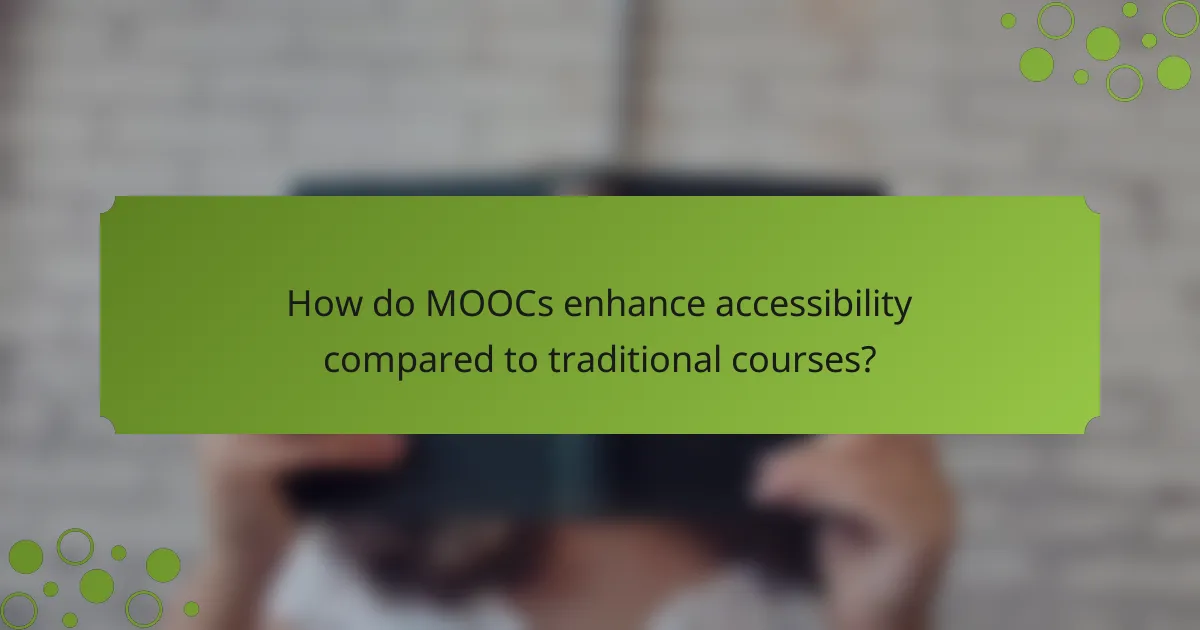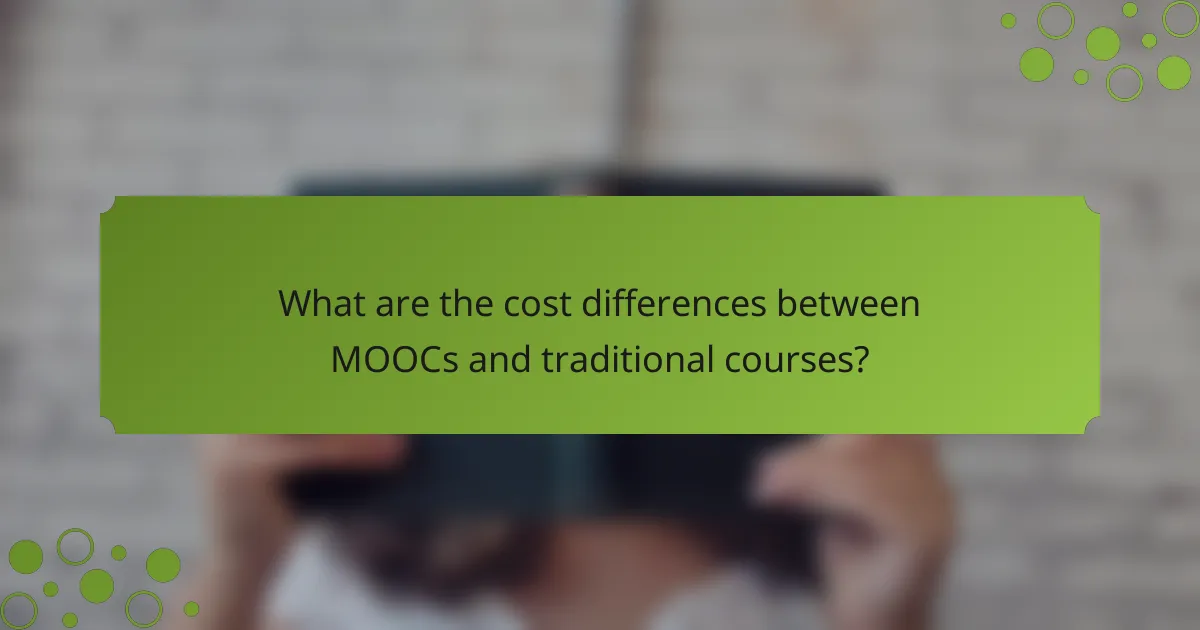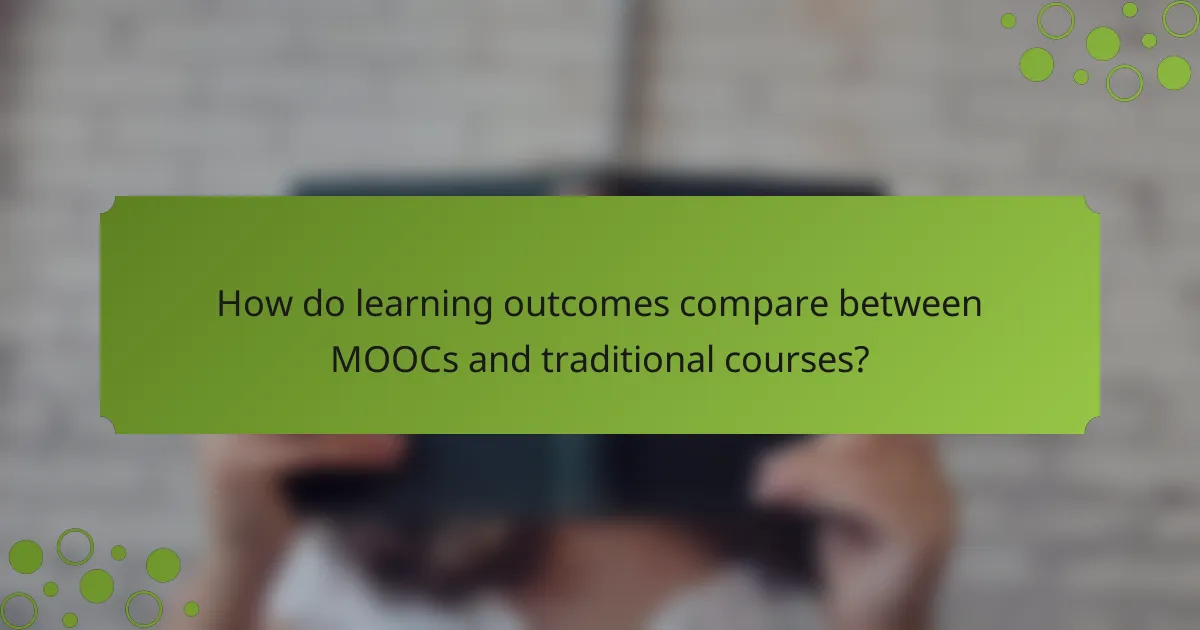
MOOCs, or Massive Open Online Courses, have transformed the educational landscape by enhancing accessibility and reducing costs, making learning opportunities available to a broader audience. Unlike traditional courses that often come with significant tuition fees, MOOCs can be accessed for free or at a minimal cost, appealing to those with financial constraints. However, the learning outcomes may vary, as traditional courses typically offer a more structured environment that can lead to better retention and recognition by employers.

How do MOOCs enhance accessibility compared to traditional courses?
MOOCs, or Massive Open Online Courses, significantly improve accessibility by allowing learners to access educational content from anywhere, often at little to no cost. This flexibility enables a wider range of individuals, including those in remote areas or with financial constraints, to pursue learning opportunities that traditional courses may not provide.
Online availability
MOOCs are hosted on various online platforms, making them accessible from any device with internet connectivity. This eliminates geographical barriers, allowing learners to engage with course materials at their convenience. Many MOOCs offer free enrollment, which further enhances accessibility for those who may not afford traditional tuition fees.
Flexible scheduling
Unlike traditional courses that follow a fixed timetable, MOOCs allow learners to study at their own pace. This flexibility accommodates different lifestyles, enabling individuals to balance education with work or family commitments. For instance, students can choose to complete assignments and watch lectures during evenings or weekends, fitting their studies around other responsibilities.
Global reach
MOOCs attract participants from around the world, fostering a diverse learning community. This global reach allows learners to connect with peers and instructors from various cultural backgrounds, enriching the educational experience. Additionally, many MOOCs offer content in multiple languages, further broadening access for non-native English speakers.

What are the cost differences between MOOCs and traditional courses?
MOOCs (Massive Open Online Courses) generally have lower costs compared to traditional courses offered by universities. While MOOCs can be free or have minimal fees, traditional courses often involve significant tuition and associated expenses.
Tuition fees
Tuition fees for traditional courses can range from a few thousand to tens of thousands of dollars per year, depending on the institution and program. In contrast, many MOOCs are available for free, with some charging a nominal fee for certification, typically between $30 and $300.
For example, a public university in the U.S. may charge around $10,000 annually for in-state students, while an online course from a reputable MOOC platform might only require a one-time payment for a certificate.
Additional expenses
Traditional courses often come with additional expenses such as textbooks, lab fees, and housing costs, which can significantly increase the total cost of education. These expenses can add thousands of dollars to the overall budget.
MOOCs, on the other hand, usually do not have these extra costs. Most materials are provided online at no charge, and learners can study from home, eliminating travel and accommodation expenses.
Financial aid options
Traditional institutions typically offer various financial aid options, including scholarships, grants, and student loans, making education more accessible for many students. These options can help cover tuition and additional costs.
MOOCs may have limited financial aid, but some platforms offer financial assistance for those who cannot afford certification fees. It’s advisable to check individual course offerings for specific aid opportunities.

How do learning outcomes compare between MOOCs and traditional courses?
Learning outcomes for MOOCs and traditional courses can differ significantly in terms of skill acquisition, certification value, and employer recognition. While MOOCs offer flexibility and accessibility, traditional courses often provide a more structured environment that can enhance learning retention and application.
Skill acquisition
MOOCs typically focus on self-directed learning, allowing students to progress at their own pace. This can lead to varied skill acquisition, as some learners thrive in this environment while others may struggle without direct guidance. Traditional courses, on the other hand, often include hands-on activities and real-time feedback, which can enhance the learning experience and lead to more consistent skill development.
For example, a student taking a MOOC on programming may learn the basics but miss out on collaborative projects that reinforce those skills, which are often part of a traditional curriculum. Therefore, individuals should consider their learning style when choosing between these options.
Certification value
Certification from traditional courses is often viewed as more credible by employers, particularly when it comes from recognized institutions. These certifications usually require a significant investment of time and effort, which can signal commitment and competence to potential employers.
In contrast, MOOCs provide certificates that can vary in value. Some are well-regarded, especially if they come from prestigious universities, while others may not carry the same weight. It’s essential for learners to research the reputation of the MOOC provider to ensure their certification will be recognized in their field.
Employer recognition
Employers often prioritize degrees and certifications from traditional educational institutions, especially for roles requiring specialized knowledge. However, there is a growing acceptance of MOOC certifications, particularly in tech and digital fields, where skills can be more important than formal education.
To improve recognition, individuals should supplement MOOC certifications with practical experience, such as internships or projects, and actively network within their industry. This combination can enhance employability and demonstrate a commitment to continuous learning.

What criteria should be considered when choosing between MOOCs and traditional courses?
When deciding between MOOCs and traditional courses, consider factors such as your learning style, career objectives, and the specific content of the courses. Each option offers unique advantages and limitations that can significantly impact your educational experience and outcomes.
Learning style
Your learning style plays a crucial role in determining whether MOOCs or traditional courses are more suitable for you. If you thrive in structured environments with direct interaction, traditional courses may be preferable. Conversely, if you are self-motivated and prefer flexible schedules, MOOCs can provide the freedom to learn at your own pace.
Consider how you absorb information best. Visual learners might benefit from video lectures in MOOCs, while kinesthetic learners may find hands-on activities in traditional settings more effective. Assess your preferences to choose the format that aligns with your learning habits.
Career goals
Your career goals can influence your choice between MOOCs and traditional courses. If you seek a degree or formal qualification for career advancement, traditional courses are often necessary, as they provide recognized credentials. However, if you aim to acquire specific skills or knowledge for a job change, MOOCs can offer targeted training without the commitment of a full degree program.
Evaluate the requirements of your desired profession. Some fields prioritize formal education, while others value practical skills and experience. Research industry standards to determine which educational path aligns with your career aspirations.
Course content
The content of the courses is a key factor when comparing MOOCs and traditional courses. MOOCs often cover a wide range of topics and are updated frequently, providing access to the latest information and trends. Traditional courses may offer a more comprehensive curriculum with a structured progression through foundational concepts.
Examine the syllabus and learning outcomes of each option. MOOCs may allow you to explore niche subjects that traditional programs do not cover. However, ensure that the course content aligns with your learning objectives and provides the depth necessary for your field of interest.

What are the advantages of traditional courses over MOOCs?
Traditional courses offer several advantages over MOOCs, including enhanced personal interaction, a structured learning environment, and valuable networking opportunities. These factors can significantly impact the overall educational experience and outcomes for students.
Personal interaction
One of the main advantages of traditional courses is the personal interaction between students and instructors. This face-to-face communication allows for immediate feedback and clarification of complex topics, fostering a deeper understanding of the material.
In a classroom setting, students can engage in discussions, ask questions, and participate in group activities, which can enhance learning. This level of interaction is often lacking in MOOCs, where communication is primarily through forums or emails.
Structured environment
Traditional courses provide a structured environment that can help students stay focused and motivated. With set schedules for classes, assignments, and exams, students are more likely to adhere to a consistent study routine.
This structure can be particularly beneficial for those who struggle with self-discipline or time management. In contrast, MOOCs often allow for more flexibility, which can lead to procrastination and incomplete coursework.
Networking opportunities
Traditional courses often create networking opportunities that are less accessible in MOOCs. Students can build relationships with peers, instructors, and industry professionals through in-person interactions and events.
These connections can lead to internships, job opportunities, and collaborations that may not be available to those who complete online courses. Engaging with a community of learners can also enhance motivation and accountability.

What emerging trends are shaping the future of online education?
Emerging trends in online education are primarily driven by advancements in technology, changing learner preferences, and the increasing demand for flexible learning options. These trends include personalized learning experiences, the integration of artificial intelligence, and a growing emphasis on skills-based training.
Accessibility
Online education has significantly improved accessibility for learners worldwide, breaking geographical and financial barriers. Many MOOCs (Massive Open Online Courses) offer free or low-cost options, allowing individuals from diverse backgrounds to access quality education.
However, accessibility also involves considering digital literacy and technology access. Not all learners have the same level of comfort with online platforms, which can impact their ability to engage fully with the material. Institutions must provide support and resources to bridge these gaps.
Cost Differences
The cost of online courses typically ranges from free to several hundred dollars, depending on the provider and course complexity. Traditional courses, especially at universities, often involve tuition fees that can reach thousands of dollars annually.
While MOOCs offer a more affordable alternative, students should consider additional costs such as certification fees or supplementary materials. It’s essential to evaluate the overall value of a course, including potential job market advantages, when comparing costs.
Learning Outcomes
Learning outcomes for online courses can vary widely, influenced by course design, instructor engagement, and learner motivation. Studies suggest that well-structured online programs can yield outcomes comparable to traditional education, particularly when they incorporate interactive elements and peer collaboration.
However, self-directed learning in MOOCs requires discipline and initiative. Students should set clear goals and actively participate in discussions and activities to enhance their learning experience. Institutions should also focus on providing robust assessments to measure and improve learning outcomes effectively.


